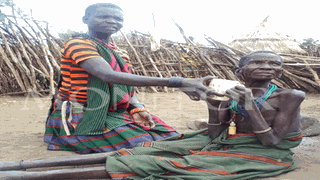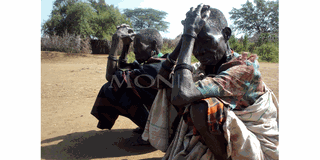
A woman helps an old woman drink water in Atedeoi Village, Lotisan Sub-county, Moroto District. PHOTOS/SIMON PETER EMWAMU
|Special Reports
Prime
Hunger kills 900 in Karamoja - leaders
What you need to know:
- Eight in every 10 Karimojong households have no or limited food and leaders claim hunger-related diseases have killed more than 900 residents since start of the year, with the misery made worse by uptick in raids and massive crop failure as a result of drought.
The suffering and pain in Karamoja, Uganda’s north-eastern pastoralist region, needs no hyperbole.
It is visible in massive crop failures as a result of a long dry spell. The scorched gardens and pasture mean limited or no food for both humans and their animals. Yet, cattle keeping provides main livelihood.
The strong heat wave has terminated torrents of water that gurgled from Mt Moroto, turning the valley of life it coursed through into a shallow sand bed and killer of aquatic life. And crops in gardens are sterile when sorghum should be fast-maturing this season.

Women in Lolachat Sub-county, Nabilatuk District in Karamoja Sub-region, which has been pounded by hunger in the recent months. PHOTO/SIMON PETER EMWAMU
Eight in every ten households here are either critically food-insecure or simply food-insecure, according to United Nations International Children’s Emergency Fund (Unicef) and government of Uganda statistics, meaning they have no food to eat or limited stock, barely lasting a month to three.
Dr Paul Lokubal, a Chevening alumnus and current doctoral student of population health at the University of Oxford, hails from Karamoja and on July 14 set up a GoFundMe account to raise Pounds20,000 (Shs96m) to feed afford “4,000 people one meal a day for a month”.
“[Many] people have died of hunger in the last two weeks alone”, he wrote, “Another 23,000 children face severe acute malnutrition and could die in the following days if they do not receive emergency help.”
By 7:36pm, 88 donors had raised £4,203 (Shs20m) in support of the online campaign.
Back in Dr Lokubal’s Karamaoja birth place, multiple leaders, citing compilations by local governments and the domestic spy agency, ISO, said over 900 Karimojong, mainly children and elderly, have succumbed to hunger-related diseases since February, this year.
The death toll is rising, but help, including the government’s 790 metric tonnes of maize flour and beans trucked to the famine hotspot last week, have been slow to reach the most in need and too small a handout.
Among the most at risk are underfed HIV and Tuberculosis (TB) patients on strong daily drugs, but lack proper dieting, let alone food to eat in sufficient quantities.
But there is another layer of trouble, a recurrent one --- cattle rustling.
Insecurity caused by these raids blamed on local warriors prompted a counter-operation by UPDF, Uganda’s army, which says it has taken 400 suspects into custody since May 16.
Hides for meal
Many of these are energetic youth whose vibrancy powers Karamoja, meaning their arrests spell additional doom for families where they were bread winners.
“It is hard to explain our situation to outsiders until they visit our settlements,” says Mr John Robert Adupa, the chairperson of Lotisan Sub-county.
Mr Adupa told this publication on Tuesday that in Lotisan alone, 22 people have died due hunger-related diseases.
“There is barely anything to harvest, crops have withered, people need food from the government, but it’s yet to come. Now some have resorted to boiling skins and hides of goats, cows as food,” he explained, sounding distraught.

A child eats porridge in Rupa Sub-county, Moroto District on July 19, 2022. PHOTO/SIMON PETER EMWAMU
Kotido, Kaabong, Moroto, Napak, and Amudat are districts in Karamoja. Their leaders last Thursday that each of the districts had received 100 tons and 50 tons of posho (maize flour) and beans, respectively, out of the government donation.
In Atedeoi village, Lotisan Sub-county, Moroto District, children with distended bellies, which health professionals attribute to malnutrition, gaze at passerby with inquisitiveness. They talk nothing, only blank stares.
The granaries erected on the compounded in communal settlements are not stocked; they ran out of food way back in February.
Wrapped in traditional sheets, some of the starving children sunbath without aim as some of their school-going peers charge to school for a free meal of boiled beans and maize grain provided under an arrangement with the UN food agency, the World Food Programme.
Mr John Bosco Longora is a district councillor representing Lotisan Sub-county. A number of famine-related deaths go unreported, he said, while starvation takes HIV and tuberculosis patients requiring higher nutrition early to their graves.
It’s here at Atedeoi, where this newspaper came across a 79-year-old Lokuruka Nabola, who had spent three days eating wild leaves. The price of a kilogramme of maize flour, commonly called posho, has more than doubled in Moroto Town to Shs5,000, while the price of a kilogramme of beans has hit Shs4,000.
Ms Betty Nakiru said her mother-in-law is so weak and can now only crawl.
Snatching of cattle and goats during raids has meant limited access to milk and beef, said 33-year-old Ms Nakiru, contrasting her experience of plentiful food while growing up.
Ms Lokuruka Nabola said it is her son who was a breadwinner, but when the army arrested him over allegations of being a warrior, life has never been easy.
626 confirmed dead in Kotido
Mr Lote Paul Kodet, the Kotido chairperson, said the district has lost 626 residents, mainly elders and children aged 3-6, to hunger-related causes over five months from February.
He offered the following breakdown of the death tolls in Kacheri Sub-county and Kacheri Town council 336: Nakapelimoru Sub-county (88), Kamol Sub-county (68), Napupum (35), Lochel Sub-county (7), Maru (45), and Kotido Sub-county (53).
“NRM government should come to the rescue of the people of Kotido by providing adequate food supply to all households,” he said.

Women sit at a compound in Lokopo in Napak District on July 19, 2022.
Mr Kodet said food trucked to the area in five lorries was dispatched to five worst-affected sub-counties out 19, leaving the majority without relief.
He added that for two years there has been no proper harvest in Kotido. Drought and cattle raids added new layers of misery.
READ LETTER: Karamoja needs urgent support
Mr Robert Kennedy Okuda, the Kotido production officer, said of 165,466 people in the district, half barely have a meal.
He said 77 percent of the people are in urgent need of aid.
Mr Okuda said a combination of skyrocketing prices, insecurity, and army worms worsened the food scarcity problem.
He said there is a need to have a contingency plan so that we have a better picture of looming hunger.
260 dead in Kaabong
In Kaabong, District chairperson Jino Meri said data compiled by the district internal security officer (DISO) showed 259 people died due to starvation in the district between January and July, this year.
By June 2022, two in every ten children in Kaabong was malnourished, he said, citing Unicef statistics.
“The DISO office has captured the details of the people who have die…the situation is bad,” he said.
While likening to current hunger situation to 1979-1980 famine, Mr Meri asked the “government to bend the procurement procedures and have Shs135b they have allocated to buy food as soon as possible”.
More deaths in Napak
Napak chairman Paul Kodet said hunger-related causes have claimed 49 lives in the district, the
Only 640 people out of 163,000 in need in Napak have received relief food from the government, he said, adding “I will not want to be a lamenting leader but offer solutions”.
Mr Kodet said insecurity brought by raiders have left communities that depended on cattle products were left with nothing.
He asked security forces to restore peace in Karamoja. “This will see the heads [of cattle] multiply without interferences,” he said, adding that locals dread going to markets where they traded cattle and bought affordable grain trucked from other regions.
The most vulnerable
Ms Adio Nawok, resident of Nadunget Sub-county, said many relatives on HIV and TB drugs pass on early due to underfeeding and poor dieting.
“Food rations have not come our way, but even amidst assurances that the food will be delivered, some LCs are extorting money from desperate persons in order to be included on the list [of relief food recipients],” she revealed.
However, George William Wopowa, the Moroto resident district commissioner, promised a crackdown on extortionists.
Moroto’s burden
District production officer for Moroto, Mr Francis Inangolet Olaki, said 24,864 households there are either critically food insecure or food insecure, while a handful are food secure.
ALSO READ: Govt sends more relief food to Karamoja
Mr Inangolet said slightly over 1,000 households in Tapac Sub-county are food secure, 1,520 food insecure and another similar number critically food insecure.
In Rupa Sub-county, the district production officer said the number of critically food insecure and food insecure households is tenfold higher than 586 food secure families.
There are three people without food guarantees for every food secure person in Nadunget Sub-county while in Katikekile Sub-county, there are double food-insecure households food-secure ones.
School without food
Mr Lazarus Kyuha, the Lolachat Seed Secondary School head teacher, said they plan to close the institution with 409 students earlier due to shortage of food that parents provided.
“We are short of food to feed the students, and as school management, we have written to the district about our intention to close (early),” he said.
According to Nabilatuk District chairman Paul Lokol, they have written to the Office of Prime Minister, which coordinates government programmes and hosts the Disaster Preparedness ministry, to aid the school with some food.
The situation in Amudat District, which has a population of 148,000, is dire too.
Mr Joseph Lobot, the district chairman, said because most cattle markets within Karamoja remain closed, residents now cross to Kenya to buy grain.
About food insecurity in Karamoja
Karamoja, located in the north-east, is one of the poorest regions in Uganda, with income poverty at 61 percent and food poverty at 70 percent (UNHS, 2016/2017). The region comprises four livelihood zones i.e. sorghum-livestock zone, maize-livestock zone, mixed crop zone and apiarypotato zone.
The population is mainly rural, with livelihoods based on livestock and crop production, and of recent, a growing range of diversified livelihood activities.
The region continues to have the highest food insecurity and malnutrition levels in Uganda, due to factors related to inadequate food, poor dietary diversity, structural poverty, limited livelihood options, poor hygiene and sanitation, and disease- Source: reliefweb.int




